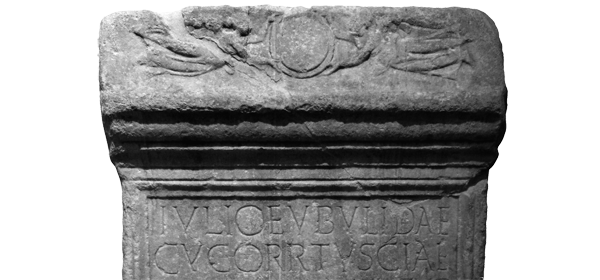


| MTK | Onlinepublication | A01UP2 | Collaborative Research Centre 933 of the German Research Foundation. Material Text Cultures. Materiality and Presence of Writing in Non-Typographic Societies |
 |
|
The late antique inscriptions of Tuscia et Umbria |
|
Subproject |
|
Teilprojekt A01 UP2
des SFB933 |
Lettered and inscribed. Inscriptions in urban space in the greco-roman period and Middle Ages. Late Antique Culture(s) of Inscription in the Imperium Romanum – on the Changes in Communication Structures and Commemorative Media at the End of Antiquity |
Members |
|
Description InstitutionHeidelberg University: Zentrum für Altertumswissenschaften (ZAW) - Seminar for Ancient History and Epigraphy Keywordsfrühes Christentum, Kirche, Stifterinschrift, Bauinschrift, Mosaikinschrift, Mosaik, Topologie |
The late antique inscriptions of Tuscia et Umbria This database contains all the 'monumental' late antique inscriptions from the Italian province of Tuscia et Umbria. The time span considered is that conventionally adopted for the period of 'Late Antiquity', i.e. from the beginning of the reign of Diocletianus in 284 AD until the end of the 6th century. It is with Diocletian's administrative reforms that the province of Tuscia et Umbria came into being. Its territory comprised the former Augustan regio VII (Etruria) and the western part of the regio VI (Umbria), thus spanning from the cities immediately north of Rome to the slopes of the Northern and Central Appenine Mountains. Like the other newly-created provinces of Italy, Tuscia et Umbria was governed by a corrector and, after 366, by a consularis who perhaps resided in Florentia (Florence). The types of inscriptions here collected are those that pertain to the (more or less) 'public' sphere of ancient (urban) life, such as honorific, building and funerary inscriptions. We have also included those inscriptions which were set in a 'private' context but were intended as monuments to be displayed, such as statue bases and mosaics, or those that were issued by a public authority, such as military diplomas. Only epigraphic artefacts that can be classified as instrumenta, label inscriptions or similar types have not been considered. The great majority of inscriptions is composed of funerary texts (519 records), nearly half of which are concentrated in the catacombs of Northern Latium (Bolsena, Rignano Flaminio, Capena, Nepi) and in the Catacomb of S. Mustiola in Chiusi. The remaining 104 inscriptions, though making up only less than a quarter of the total figure, are nevertheless from an historical perspective the most informative ones, since they testify to the vitality of institutional life and civic bodies well into the later 4th century (and sometimes beyond), as well as to building and restoring activities of various kinds. Building inscriptions are mainly Christian and related to the construction and decoration of churches, with only very few examples referring instead to the maintenance of secular buildings, namely baths. Milestones are not very numerous in our sample; they seem to testify to an interest in the maintenance of public infrastructures, but had mainly become honorific monuments for the reigning Emperors erected alongside the main roads by this time. As common elsewhere in the Roman world, the late antique milestone inscriptions were often engraved below or to the side of earlier texts, on reused monuments rather than on new ones. Honorific inscriptions, that is texts accompanying a statue and belonging to a more traditional form of homage, are on the other hand quite numerous and scattered throughout the whole province, showing that the connections between the cities and their distinguished inhabitants, their patrons and their governors were still tight. Also inscriptions in honour of late antique Emperors set up mainly by the council of the cities are attested in a good number, mainly from the late 3rd and earlier 4th century. In our Tuscia et Umbria-database the material aspects related to inscriptions have been explored in all the ways made possible by the extant bibliography and documentation. Whenever the inscription is preserved, a detailed description has been given containing the features of the support (esp. decoration and the history of its uses and reuses) as well as the features of the text (layout, letter form, paratextual elements). A particular emphasis has been put on aspects related to find context and original display context, in the effort to reconstruct as much as possible of the original setting of such epigraphic monuments. Inscribed stones suffered, however, from late antique, post antique and modern deploy, with a series of reuses and displacements that could become very complex and that would carry the pieces far away from their original position. Even inscriptions set in 'closed' contexts, such as those put up in catacombs, sometimes could not escape this fate, since medieval and modern restorations and especially 18th century martyrs' seekers determined the reuse and destruction of many of them. |
Further Reading |
Katharina Bolle, Spätantike Inschriften in Tuscia et Umbria: Materialität und Präsenz, in The Epigraphic Cultures of Late Antiquity, ed. by K. Bolle, C. Machado, Ch. Witschel, Stuttgart 2017, pp. 147-212. |
Data |
Will follow soon. |
Contact |
Heidelberg University Telephone: +49-(0)6221-542233 (secretariat) |
Conditions of use |
|
Research Funding |
|